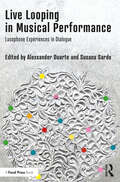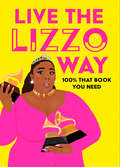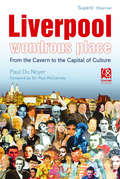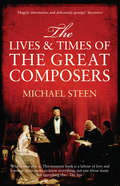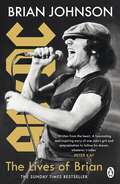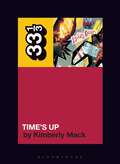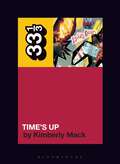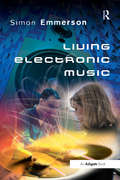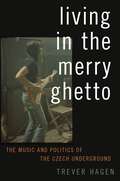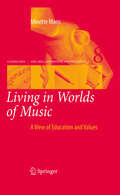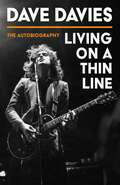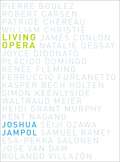- Table View
- List View
Live and Recorded: Music Experience in the Digital Millennium
by Yngvar KjusThis book uncovers how music experience–live and recorded–is changing along with the use of digital technology in the 2000s. Focussing on the Nordic region, this volume utilizes the theory of mentalization: the capacity to perceive and interpret what others are thinking and feeling, and applies it to the analysis of mediated forms of agency in popular music. The rise of new media in music production has enabled sound recording and processing to occur more rapidly and in more places, including the live concert stage. Digital technology has also introduced new distribution and consumption technologies that allow record listening to be more closely linked to the live music experience. The use of digital technology has therefore facilitated an expanding range of activities and experiences with music. Here, Yngvar Kjus addresses a topic that has a truly global reach that is of interest to scholars of musicology, media studies and technology studies.
Live Electronic Music: Composition, Performance, Study (Routledge Research in Music)
by Friedemann Sallis Valentina Bertolani Jan Burle Laura ZattraDuring the twentieth century, electronic technology enabled the explosive development of new tools for the production, performance, dissemination and conservation of music. The era of the mechanical reproduction of music has, rather ironically, opened up new perspectives, which have contributed to the revitalisation of the performer’s role and the concept of music as performance. This book examines questions related to music that cannot be set in conventional notation, reporting and reflecting on current research and creative practice primarily in live electronic music. It studies compositions for which the musical text is problematic, that is, non-existent, incomplete, insufficiently precise or transmitted in a nontraditional format. Thus, at the core of this project is an absence. The objects of study lack a reliably precise graphical representation of the work as the composer or the composer/performer conceived or imagined it. How do we compose, perform and study music that cannot be set in conventional notation? The authors of this book examine this problem from the complementary perspectives of the composer, the performer, the musical assistant, the audio engineer, the computer scientist and the musicologist.
Live Electronic Music: Composition, Performance, Study (Routledge Research in Music)
by Friedemann Sallis Laura Zattra Ian Burleigh Valentina Bertolani Janet BurlesonDuring the twentieth century, electronic technology enabled the explosive development of new tools for the production, performance, dissemination and conservation of music. The era of the mechanical reproduction of music has, rather ironically, opened up new perspectives, which have contributed to the revitalisation of the performer’s role and the concept of music as performance. This book examines questions related to music that cannot be set in conventional notation, reporting and reflecting on current research and creative practice primarily in live electronic music. It studies compositions for which the musical text is problematic, that is, non-existent, incomplete, insufficiently precise or transmitted in a nontraditional format. Thus, at the core of this project is an absence. The objects of study lack a reliably precise graphical representation of the work as the composer or the composer/performer conceived or imagined it. How do we compose, perform and study music that cannot be set in conventional notation? The authors of this book examine this problem from the complementary perspectives of the composer, the performer, the musical assistant, the audio engineer, the computer scientist and the musicologist.
Live Fast, Die Young: Misadventures in Rock And Roll America
by Chris Price Joe HarlandDisappointed to learn that Hotel California isn’t actually in the phone book, radio producers Chris and Joe resolve to seek out the true spirit of rock and roll America. Roof down and stereo up, they drive coast to coast on a mission to ‘live the music’. It’s a tale of friendship tested to the limit, great melodies, and noble myths.
Live Looping in Musical Performance: Lusophone Experiences in Dialogue
by Alexsander Duarte Susana SardoLive Looping in Musical Performance offers a diverse range of interdisciplinary perspectives on the application of live looping technology by lusophone performers and composers. This book explores various aspects, including the aesthetic component, instrumentation, and setup, highlighting the versatility of this technology in music-making. Written by musicians and researchers from Portuguese-speaking countries, this book comprises eleven chapters that delve into various musical contexts, genres, and practices. The novelty of including collaborative texts written alongside non-professional researchers offers the possibility of drawing from real experience to consider how live looping has been changing and "cyborguising" the concept of music, the ritual of the performance, the identity of the musicians, and the public's expectations. Live Looping in Musical Performance provides cutting-edge reading for composers and performers, as well as ethnomusicologists, students, and researchers working in the areas of music production, technology, and performance. This book addresses a broader audience, both academic and non-academic, who are interested in new processes of musical creativity in a post-human world.
Live Looping in Musical Performance: Lusophone Experiences in Dialogue
Live Looping in Musical Performance offers a diverse range of interdisciplinary perspectives on the application of live looping technology by lusophone performers and composers. This book explores various aspects, including the aesthetic component, instrumentation, and setup, highlighting the versatility of this technology in music-making. Written by musicians and researchers from Portuguese-speaking countries, this book comprises eleven chapters that delve into various musical contexts, genres, and practices. The novelty of including collaborative texts written alongside non-professional researchers offers the possibility of drawing from real experience to consider how live looping has been changing and "cyborguising" the concept of music, the ritual of the performance, the identity of the musicians, and the public's expectations. Live Looping in Musical Performance provides cutting-edge reading for composers and performers, as well as ethnomusicologists, students, and researchers working in the areas of music production, technology, and performance. This book addresses a broader audience, both academic and non-academic, who are interested in new processes of musical creativity in a post-human world.
The Live Music Business: Management and Production of Concerts and Festivals
by Andy ReynoldsThe Live Music Business: Management and Production of Concerts and Festivals, Third Edition, shines a light on the enigmatic live music business, offering a wealth of inside advice and trade secrets to artists and bands looking to make a living in the industry. Previously published as The Tour Book, this new edition has been extensively revised, reorganized, and updated to reflect today’s music industry. This practical guidebook examines the roles of the key players – from booking agents to concert promoters, artist managers to talent buyers – and the deals, conventions, and processes that drive this global business. Written by a touring professional with over 25 years of experience, this book elucidates why playing live is crucial to the success of any musician, band, or artist, explaining issues like: what managers, promoters, and agents do and how they arrange shows and tours; how to understand and negotiate show contracts; how to create a contract rider, and how the rider affects the money you earn from a show; how to appear professional and knowledgeable in an industry with its own conventions, language, and baffling technical terms; and a three-year plan using live performance to kickstart your music career Intended for music artists and students, The Live Music Business presents proven live-music career strategies, covering every aspect of putting on a live show, from rehearsing and soundchecks to promotions, marketing, and contracts. In an era when performing live is more essential than ever, this is the go-to guidebook for getting your show on the road and making a living from music.
The Live Music Business: Management and Production of Concerts and Festivals
by Andy ReynoldsThe Live Music Business: Management and Production of Concerts and Festivals, Third Edition, shines a light on the enigmatic live music business, offering a wealth of inside advice and trade secrets to artists and bands looking to make a living in the industry. Previously published as The Tour Book, this new edition has been extensively revised, reorganized, and updated to reflect today’s music industry. This practical guidebook examines the roles of the key players – from booking agents to concert promoters, artist managers to talent buyers – and the deals, conventions, and processes that drive this global business. Written by a touring professional with over 25 years of experience, this book elucidates why playing live is crucial to the success of any musician, band, or artist, explaining issues like: what managers, promoters, and agents do and how they arrange shows and tours; how to understand and negotiate show contracts; how to create a contract rider, and how the rider affects the money you earn from a show; how to appear professional and knowledgeable in an industry with its own conventions, language, and baffling technical terms; and a three-year plan using live performance to kickstart your music career Intended for music artists and students, The Live Music Business presents proven live-music career strategies, covering every aspect of putting on a live show, from rehearsing and soundchecks to promotions, marketing, and contracts. In an era when performing live is more essential than ever, this is the go-to guidebook for getting your show on the road and making a living from music.
Live Music in America: A History from Jenny Lind to Beyoncé
by Steve WaksmanWhen the Swedish concert singer Jenny Lind toured the U.S. in 1850, she became the prototype for the modern pop star. Meanwhile, her manager, P.T. Barnum, became the prototype for another figure of enduring significance: the pop culture impresario. Starting with Lind's fabled U.S. tour and winding all the way into the twenty-first century, Live Music in America surveys the ongoing impact and changing conditions of live music performance in the U.S. It covers a range of historic performances, from the Fisk Jubilee Singers expanding the sphere of African American music in the 1870s, to Benny Goodman bringing swing to Carnegie Hall in 1938, to 1952's Moondog Coronation Ball in Cleveland - arguably the first rock and roll concert - to Beyoncé's boundary-shattering performance at the 2018 Coachella festival. More than that, the book details the roles played by performers, audiences, media commentators, and a variety of live music producers (promoters, agents, sound and stage technicians) in shaping what live music means and how it has evolved. Live Music in America connects what occurs behind the scenes to what takes place on stage to highlight the ways in which live music is very deliberately produced and does not just spontaneously materialize. Along the way, author Steve Waksman uses previously unstudied archival materials to shed new light on the origins of jazz, the emergence of rock 'n' roll, and the rise of the modern music festival.
Live Music in America: A History from Jenny Lind to Beyoncé
by Steve WaksmanWhen the Swedish concert singer Jenny Lind toured the U.S. in 1850, she became the prototype for the modern pop star. Meanwhile, her manager, P.T. Barnum, became the prototype for another figure of enduring significance: the pop culture impresario. Starting with Lind's fabled U.S. tour and winding all the way into the twenty-first century, Live Music in America surveys the ongoing impact and changing conditions of live music performance in the U.S. It covers a range of historic performances, from the Fisk Jubilee Singers expanding the sphere of African American music in the 1870s, to Benny Goodman bringing swing to Carnegie Hall in 1938, to 1952's Moondog Coronation Ball in Cleveland - arguably the first rock and roll concert - to Beyoncé's boundary-shattering performance at the 2018 Coachella festival. More than that, the book details the roles played by performers, audiences, media commentators, and a variety of live music producers (promoters, agents, sound and stage technicians) in shaping what live music means and how it has evolved. Live Music in America connects what occurs behind the scenes to what takes place on stage to highlight the ways in which live music is very deliberately produced and does not just spontaneously materialize. Along the way, author Steve Waksman uses previously unstudied archival materials to shed new light on the origins of jazz, the emergence of rock 'n' roll, and the rise of the modern music festival.
Live the Lizzo Way: 100% That Book You Need
by Natty KasambalaA celebration of Lizzo’s love and light. We all want a bit more Lizzo in our lives!
Live Visuals: History, Theory, Practice (Routledge Advances in Theatre & Performance Studies)
by Steve Gibson Stefan Arisona Donna Leishman Atau TanakaThis volume surveys the key histories, theories and practice of artists, musicians, filmmakers, designers, architects and technologists that have worked and continue to work with visual material in real time. Covering a wide historical period from Pythagoras’s mathematics of music and colour in ancient Greece, to Castel’s ocular harpsichord in the 18th century, to the visual music of the mid-20th century, to the liquid light shows of the 1960s and finally to the virtual reality and projection mapping of the present moment, Live Visuals is both an overarching history of real-time visuals and audio-visual art and a crucial source for understanding the various theories about audio-visual synchronization. With the inclusion of an overview of various forms of contemporary practice in Live Visuals culture – from VJing to immersive environments, architecture to design – Live Visuals also presents the key ideas of practitioners who work with the visual in a live context. This book will appeal to a wide range of scholars, students, artists, designers and enthusiasts. It will particularly interest VJs, DJs, electronic musicians, filmmakers, interaction designers and technologists.
Live Visuals: History, Theory, Practice (Routledge Advances in Theatre & Performance Studies)
by Steve Gibson Stefan Arisona Donna Leishman Atau TanakaThis volume surveys the key histories, theories and practice of artists, musicians, filmmakers, designers, architects and technologists that have worked and continue to work with visual material in real time. Covering a wide historical period from Pythagoras’s mathematics of music and colour in ancient Greece, to Castel’s ocular harpsichord in the 18th century, to the visual music of the mid-20th century, to the liquid light shows of the 1960s and finally to the virtual reality and projection mapping of the present moment, Live Visuals is both an overarching history of real-time visuals and audio-visual art and a crucial source for understanding the various theories about audio-visual synchronization. With the inclusion of an overview of various forms of contemporary practice in Live Visuals culture – from VJing to immersive environments, architecture to design – Live Visuals also presents the key ideas of practitioners who work with the visual in a live context. This book will appeal to a wide range of scholars, students, artists, designers and enthusiasts. It will particularly interest VJs, DJs, electronic musicians, filmmakers, interaction designers and technologists.
Liverpool - Wondrous Place: From the Cavern to the Capital of Culture
by Paul Du NoyerNo other city in the world is as well known or loved for its vibrant and definitive musical history as Liverpool. In 2002, Guinness World Records: British Hit Singles voted Liverpool 'World Capital of Pop', recognising that Liverpool's homegrown talent has produced more number one hit singles per capita than anywhere else in the world. In 2008, Liverpool will celebrate its crown as European Capital of Culture. Paul Du Noyer's acclaimed book takes us on a tour of the rich musical history of his hometown, from the world-famous Cavern Club in Mathew Street, host to the Beatles' debut performance in 1961, to the city's musical future with contemporary bands like The Zutons. Featuring interviews with key figures of the music scene, this book reveals the creative impulse behind Britain's most musical city. Find out why Liverpool is not just a place where music happens. The city is the reason music happens.
The Lives and Times of the Great Composers: The Great Composers (The\great Composers Ser.)
by Michael Steen'A glorious plum-pudding of a book, to be consulted, with pleasure and profit, over and over again' Sir Jeremy Isaacs Michael Steen's 'Great Composers' was originally published in 2003. A lifetime's work and almost 1000 pages long, it has since become 'the' reference point and key read on the biographical backgrounds to classical music's biggest names. Authoritative and hugely detailed - but nonetheless a joy to read - this new edition will expand its readership further and capitalise on a newfound popular interest in classical music. Steen's book helps you explore the story of Bach, the respectable burgher much of whose vast output was composed amidst petty turf disputes in Lutheran Leipzig; or the ugly, argumentative Beethoven in French-occupied Vienna, obsessed by his laundry; or Mozart, the over-exploited infant prodigy whose untimely death was shrouded in rumour. Read about Verdi, who composed against the background of the Italian Risorgimento; or about the family life of the Wagners; and, Brahms, who rose from the slums of Hamburg to become a devotee of beer and coffee in fin-de-siecle Vienna, a cultural capital bent on destroying Mahler...and much, much more.
The Lives of Brian: The Sunday Times bestselling autobiography from legendary AC/DC frontman Brian Johnson
by Brian JohnsonTHE SUNDAY TIMES BESTSELLERTouching, personal, indomitable, but always laugh-out-loud funny, The Lives of Brian is the legendary story of one of the rock world's best-loved performers - and the many lives he's led'Both a rollicking tale of rock's bygone glory days and a deeply human account of a working-class boy who never gave up' MAIL ON SUNDAY___________For over a decade rock legend Brian Johnson tried to make his mark with a succession of bands, yet big time success remained out of reach. But was he going to give up on his dream?Not a chance . . .So when, after the tragic death of Bon Scott, AC/DC hired Brian as their new singer, he gave it his all. And his debut, Back in Black, went on to become the biggest-selling rock album of all time.Big hearted, touching, indomitable and always laugh-out-loud funny, The Lives of Brian is the story of one of the world's best-loved performers, told in his own inimitable voice.___________'The Lives of Brian is the literary twin of a classic AC/DC album - wild material woven together seamlessly, and always leaving you wanting more' Hot Press'A tale of fate, serendipity and dogged determination' Mojo'A heart-wrenching and hilarious memoir' Billboard
Living Colour's Time's Up (33 1/3)
by Kimberly MackThe iconic Black rock band Living Colour's Time's Up, released in 1990, was recorded in the aftermath of the spectacular critical and commercial success of their debut record Vivid. Time's Up is a musical and lyrical triumph, incorporating distinct forms and styles of music and featuring inspired collaborations with artists as varied as Little Richard, Queen Latifah, Maceo Parker, and Mick Jagger. The clash of sounds and styles don't immediately fit. The confrontational hardcore-thrash metal - complete with Glover's apocalyptic wail - in the title track is not a natural companion with Doug E. Fresh's human beat box on “Tag Team Partners,” but it's precisely this bold and brilliant collision that creates the barely-controlled chaos. And isn't rock & roll about chaos?Living Colour's sophomore effort holds great relevance in light of its forward-thinking politics and lyrical engagement with racism, classism, police brutality, and other social and political issues of great importance. Through interviews with members of Living Colour, and others involved in the making of Time's Up, Kimberly Mack explores the creation and reception of this artistically challenging album, while examining the legacy of this culturally important and groundbreaking American rock band.
Living Colour's Time's Up (33 1/3)
by Kimberly MackThe iconic Black rock band Living Colour's Time's Up, released in 1990, was recorded in the aftermath of the spectacular critical and commercial success of their debut record Vivid. Time's Up is a musical and lyrical triumph, incorporating distinct forms and styles of music and featuring inspired collaborations with artists as varied as Little Richard, Queen Latifah, Maceo Parker, and Mick Jagger. The clash of sounds and styles don't immediately fit. The confrontational hardcore-thrash metal - complete with Glover's apocalyptic wail - in the title track is not a natural companion with Doug E. Fresh's human beat box on “Tag Team Partners,” but it's precisely this bold and brilliant collision that creates the barely-controlled chaos. And isn't rock & roll about chaos?Living Colour's sophomore effort holds great relevance in light of its forward-thinking politics and lyrical engagement with racism, classism, police brutality, and other social and political issues of great importance. Through interviews with members of Living Colour, and others involved in the making of Time's Up, Kimberly Mack explores the creation and reception of this artistically challenging album, while examining the legacy of this culturally important and groundbreaking American rock band.
Living Electronic Music
by Simon EmmersonDrawing on recent ideas that explore new environments and the changing situations of composition and performance, Simon Emmerson provides a significant contribution to the study of contemporary music, bridging history, aesthetics and the ideas behind evolving performance practices. Whether created in a studio or performed on stage, how does electronic music reflect what is live and living? What is it to perform 'live' in the age of the laptop? Many performer-composers draw upon a 'library' of materials, some created beforehand in a studio, some coded 'on the fly', others 'plundered' from the widest possible range of sources. But others refuse to abandon traditionally 'created and structured' electroacoustic work. Lying behind this maelstrom of activity is the perennial relationship to 'theory', that is, ideas, principles and practices that somehow lie behind composers' and performers' actions. Some composers claim they just 'respond' to sound and compose 'with their ears', while others use models and analogies of previously 'non-musical' processes. It is evident that in such new musical practices the human body has a new relationship to the sound. There is a historical dimension to this, for since the earliest electroacoustic experiments in 1948 the body has been celebrated or sublimated in a strange 'dance' of forces in which it has never quite gone away but rarely been overtly present. The relationship of the body performing to the spaces around has also undergone a revolution as the source of sound production has shifted to the loudspeaker. Emmerson considers these issues in the framework of our increasingly 'acousmatic' world in which we cannot see the source of the sounds we hear.
Living Electronic Music
by Simon EmmersonDrawing on recent ideas that explore new environments and the changing situations of composition and performance, Simon Emmerson provides a significant contribution to the study of contemporary music, bridging history, aesthetics and the ideas behind evolving performance practices. Whether created in a studio or performed on stage, how does electronic music reflect what is live and living? What is it to perform 'live' in the age of the laptop? Many performer-composers draw upon a 'library' of materials, some created beforehand in a studio, some coded 'on the fly', others 'plundered' from the widest possible range of sources. But others refuse to abandon traditionally 'created and structured' electroacoustic work. Lying behind this maelstrom of activity is the perennial relationship to 'theory', that is, ideas, principles and practices that somehow lie behind composers' and performers' actions. Some composers claim they just 'respond' to sound and compose 'with their ears', while others use models and analogies of previously 'non-musical' processes. It is evident that in such new musical practices the human body has a new relationship to the sound. There is a historical dimension to this, for since the earliest electroacoustic experiments in 1948 the body has been celebrated or sublimated in a strange 'dance' of forces in which it has never quite gone away but rarely been overtly present. The relationship of the body performing to the spaces around has also undergone a revolution as the source of sound production has shifted to the loudspeaker. Emmerson considers these issues in the framework of our increasingly 'acousmatic' world in which we cannot see the source of the sounds we hear.
Living in The Merry Ghetto: The Music and Politics of the Czech Underground
by Trever HagenLiving in the Merry Ghetto reframes how people use music to build resistance. Author Trever Hagen addresses the social context of illegal music-making in Czechoslovakia during state socialism. He tells the story of a group of rock'n'roll musicians who went underground after 1968, building a parallel world from where they could flourish: the Merry Ghetto. The book examines the case of the Czech Underground and the politics of their music and their way of life, paying close attention to the development of the ensemble The Plastic People of the Universe. Taking in multiple political transitions from the 1940s-2000s, the story focuses on non-official cultural practices such as listening to foreign radio broadcasts, seeking out copied cassette tapes, listening to banned LPs, growing long hair, attending clandestine concerts, smuggling albums via diplomats, recording in home-studios and being thrown in prison for any of these activities. Drawing on ethnographic interviews with Undergrounders, archival research and participant observation, Hagen shows how these practices shaped consciousness, informed bodies and promoted collective action, all of which contributed to an Underground identity.
LIVING IN THE MERRY GHETTO C: The Music and Politics of the Czech Underground
by Trever HagenLiving in the Merry Ghetto reframes how people use music to build resistance. Author Trever Hagen addresses the social context of illegal music-making in Czechoslovakia during state socialism. He tells the story of a group of rock'n'roll musicians who went underground after 1968, building a parallel world from where they could flourish: the Merry Ghetto. The book examines the case of the Czech Underground and the politics of their music and their way of life, paying close attention to the development of the ensemble The Plastic People of the Universe. Taking in multiple political transitions from the 1940s-2000s, the story focuses on non-official cultural practices such as listening to foreign radio broadcasts, seeking out copied cassette tapes, listening to banned LPs, growing long hair, attending clandestine concerts, smuggling albums via diplomats, recording in home-studios and being thrown in prison for any of these activities. Drawing on ethnographic interviews with Undergrounders, archival research and participant observation, Hagen shows how these practices shaped consciousness, informed bodies and promoted collective action, all of which contributed to an Underground identity.
Living in Worlds of Music: A View of Education and Values (Landscapes: the Arts, Aesthetics, and Education #8)
by Minette MansInformed by her in-depth ethnomusical knowledge, the result of detailed fieldwork, Mans’s book is about musical worlds and how we as people inhabit them. The book asserts that an understanding of our musical worlds can be a transformative educational tool that could have a significant role to play in multicultural music and arts education. She explores the way in which musical expression, with its myriad cultural variations, reveals much about identity and cultural norms, and shows how particular musical sounds are aesthetically related to these norms. The author goes further to suggest that similar systems can be detected across cultures, while each world remains colored by a distinctive soundscape. Mans also looks at the way each cultural soundscape is a symbolic manifestation of a society’s collective cognition, sorting musical behavior and sounds into clusters and patterns that fulfill each society’s requirements. She probes the fact that in today’s globalized and mobile world, as people move from one society to another, cross-cultural acts and hybrids result in a number of new aesthetics. Finally, in addition to three personal narratives by musicians from different continents, the author has invited scholars from diverse specializations and locations to comment on different sections of the book, opening up a critical dialogue with voices from different parts of the globe. Musical categorization, identity, values, aesthetic evaluation, creativity, curriculum, assessment and teacher education are some of the issues tackled in this manner.
Living on a Thin Line
by Dave DaviesThe all new, must-read memoir by legendary Kinks guitarist Dave Davies'BOOK OF THE DAY' - Guardian'This powerful tell-all from the Kinks guitarist puts the spotlight on his own bad behaviour, dalliances with the occult and his recovery from a stroke.' - Observer'Heartfelt, hilarious, revealing, insightful and astonishingly candid. Boy, you really got me Dave. I can't wait to read it again.' - Mark Hamill Dave Davies is the co-founder and lead guitarist of epoch-defining band the Kinks, a group with fifty million record sales to their name. In his autobiography, Davies revisits the glory days of the band that spawned so much extraordinary music, and which had such a profound influence on bands from The Clash and Van Halen to Oasis and Blur. Full of tales of the tumultuous times and the ups-and-downs of his relationship with his brother Ray, along with encounters with the likes of John Lennon and Jimi Hendrix, this will be a glorious read for Kinks fans and anyone who wants to read about the heyday of rock 'n' roll.
Living Opera
by Joshua JampolLiving Opera is a fascinating collection of 20 wide-ranging interviews with the preeminent opera professionals working on and behind the stage today. Joshua Jampol invites opera-lovers to listen in as performers such as Renee Fleming, Natalie Dessay, Rolando Villazon and Placido Domingo speak in exceptionally frank terms about their strengths and weaknesses, and address such hard-hitting, enduring topics as how they deal with critics, vocal troubles, and balancing their career and family lives. We hear conductors such as James Conlon, Esa-Pekka Salonen, and Kent Nagano discuss their likes and dislikes about the state of contemporary opera, their own inspirations, and whom they themselves hope to inspire. World-class directors such as Robert Carsen and Patrice Chéreau discuss the complexities involved in staging a successful opera, and how opera can remain relevant today. Jampol has unprecedented access to these major singers, conductors, and directors, and the table of contents reads like a "who's who" of the global opera world. Each interview highlights a distinctive voice, and Jampol brings immense knowledge and a wonderful flair to these conversations. He allows his subjects to follow their thoughts wherever they lead, and reveals in the process a more intimate, reflective side of the emotional and extravagant world of the lyric arts. For anyone wanting to know more about the people behind the performances--what they think, how they feel, and who they really are--Living Opera is full of delights and surprises.



